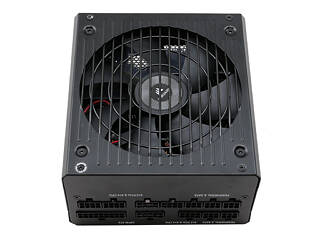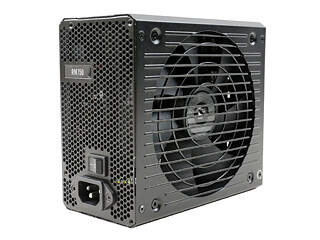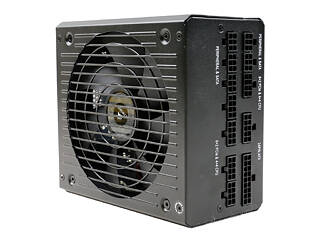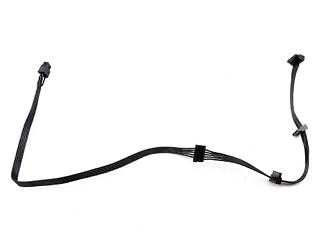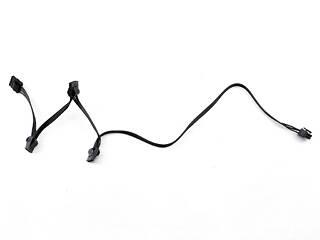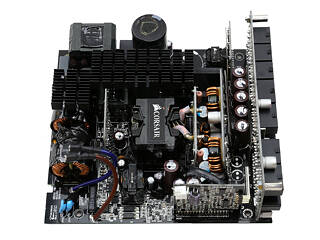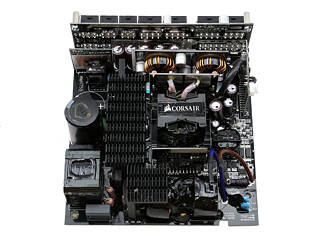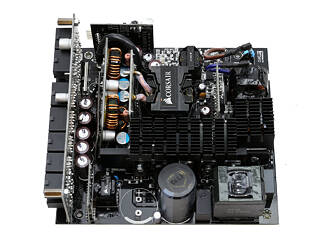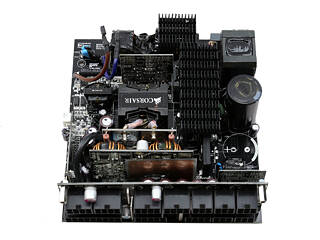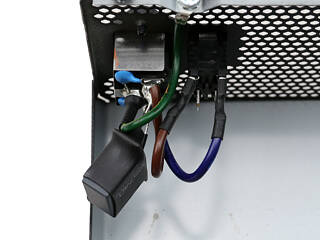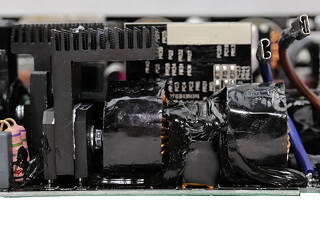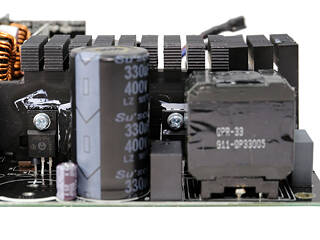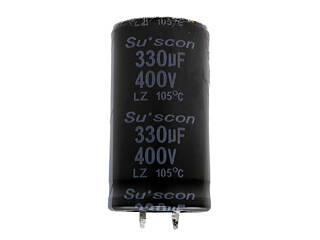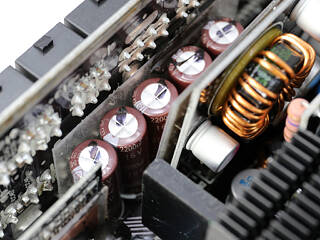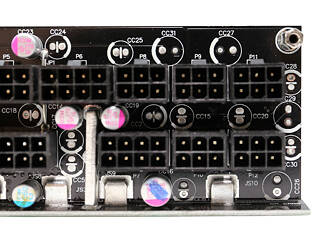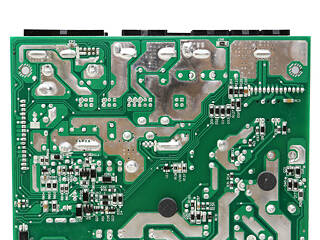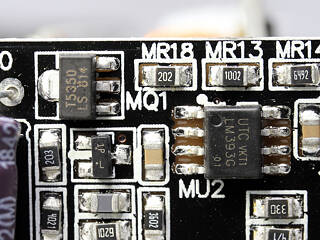 21
21
Corsair RM750 750 W Review
Load Regulation, Hold-up Time, Inrush Current, Efficiency & Noise »Introduction

We would like to thank Corsair for supplying the review sample.

Corsair's plan with the revamped RM line is to offer the same performance levels as with its popular RMx lines at more affordable prices. To achieve this, all RM models come with slightly lower-quality capacitors which will still outlive the ten-year warranty and a more affordable fan that uses a rifle bearing. So instead of the Japanese Nichicon and Chemi-Con caps and bullet-proof NR135L fan the RMx models use, you will find Chinese Elite caps and a Hong-Hua fan in their RM units.
Despite the hardware changes mentioned above, the new RM models score higher than current RMx units in some areas as efficiency levels under ultra-light loads are better and the RM models support the new Modern Standby mode in Windows 10. Depending on the hardware, it usually takes 3–15 seconds for a PC in S3 sleep mode to turn on, while the modern standby function promises to bring this time to just under five seconds. As it seems, thanks to the new standby function, our PCs will be able to wake up as fast as our mobile phones.
In today's review, I am going to take a look at the second-strongest RM model with a maximum capacity of 750 W. The RM750 is fully modular and has two EPS and six PCIe connectors, so you definitely won't be left wanting for connectors. The number of peripheral connectors is sufficient as well, and contrary to the RMx models, no in-cable caps are used for better ripple suppression. As Corsair's PSU R&D director, Mr Jon Gerow, states, extra caps on the cables don't offer notably better ripple suppression. They are mostly used to satisfy strict reviewers (me included). Well, there is a point there indeed as it doesn't matter whether the ripple is 19-20 mV or 9-10 mV, for instance.
That said, this is a race, and the brand or manufacturer offering the best performance should be awarded. Finally, if it were not for weird reviewers (like me) who always ask for more, ripple performance would be considered fine for as long as it below 120 mV at +12V as that is what the ATX spec specifies. While every side of the fence has its points, the good thing is that we can meet somewhere in the middle.
Specifications
| Corsair RM750 (2019) Features & Specifications | |
|---|---|
| Max. DC Output | 750 W |
| PFC | Active PFC |
| Efficiency | ETA-A & 80 PLUS Gold |
| Noise | LAMBDA-A (20-25 dB[A]) |
| Modular | Yes (fully) |
| Intel C6/C7 Power State Support | Yes |
| Operating Temperature | 0 °C - 50 °C |
| Protections | Over Voltage Protection Under Voltage Protection Over Power Protection Over Temperature Protection Over Current Protection Short Circuit Protection |
| Cooling | 140 mm rifle bearing fan (HA1425M12F-Z) |
| Semi-passive Operation | Yes (not selectable) |
| Dimensions | 152 mm (W) x 87 mm (H) x 162 mm (D) |
| Weight | 1.61 kg (3.55 lb) |
| Compliance | ATX12V v2.31, EPS 2.92 |
| Warranty | 10 Years |
| Price at Time of review (excl. VAT) | $129.99 |
| Corsair RM750 (2019) Power Specs | |||||||
|---|---|---|---|---|---|---|---|
| Rail | 3.3 V | 5 V | 12 V | 5 VSB | -12 V | ||
| Max. Power | 20 A | 20 A | 62.5 A | 3 A | 0.3 A | ||
| 150 W | 750 W | 15 W | 3.6 W | ||||
| Total Max. Power | 750 W | ||||||
Cables and Connectors
| Modular Cables | ||||
|---|---|---|---|---|
| Description | Cable Count | Connector Count (Total) | Gauge | In Cable Capacitors |
| ATX connector 20+4 pin (610 mm) | 1 | 1 | 18-20AWG | No |
| 4+4 pin EPS12V (650 mm) | 2 | 2 | 18AWG | No |
| 6+2 pin PCIe (600 mm+150 mm) | 3 | 6 | 16-18AWG | No |
| SATA (450 mm+110 mm+110 mm+110 mm) | 1 | 3 | 18AWG | No |
| SATA (500 mm+100 mm+100 mm) | 2 | 6 | 18AWG | No |
| 4 pin Molex (450 mm+100 mm+100 mm+100 mm) | 1 | 4 | 18AWG | No |
| AC Power Cord (1420 mm) - C13 coupler | 1 | 1 | 16AWG | - |
All cables are long enough, but the distance between the peripheral connectors is short at only 100–110 mm. It should at least be 150 mm, especially on the 4-pin Molex connectors.
Component Analysis
| Corsair RM750 Parts Description | |
|---|---|
| General Data | |
| Manufacturer (OEM) | CWT |
| PCB Type | Double-sided |
| Primary Side | |
| Transient Filter | 4x Y caps, 2x X caps, 2x CM chokes, 1x MOV |
| Bridge Rectifier(s) | 2x GBU1506(600 V, 15 A @ 100 °C) |
| Inrush Current Protection | NTC thermistor & relay |
| APFC MOSFETs | 2x Infineon IPA60R190P6(650 V, 12.7 A @ 100 °C, 0.19 Ohm) |
| APFC Boost Diode | 1x Power Integrations QH08TZ600 (600 V, 8 A @ 95 °C) |
| Hold-up Cap(s) | 2x Su'scon (400 V, 330 uF each or 660 uF combined, 2,000 h @ 105 °C LZ) |
| Main Switchers | 2x Infineon IPA60R190P6 (650 V, 12.7 A @ 100 °C, 0.19 Ohm) |
| APFC Controller | Champion CM6500UNX & CM03X Green PFC Controller |
| Switching Controller | Champion CU6901V |
| Topology | Primary side: Half-bridge & LLC converter Secondary side: Synchronous rectification & DC-DC converters |
| Secondary Side | |
| +12V | 6x International Rectifier IRFH7004PBF (40 V, 100 A @ 25 °C, 1.4 mOhm) |
| 5V & 3.3V | DC-DC converters: 2x UBIQ QM3054M6 (30 V, 61 A @ 100 °C, 4.8 mOhm) & 2x UBIQ QN3107M6N (30 V, 70 A @ 100 °C, 2.6 mOhm) PWM Controller(s): uPI SEMI uP3861P |
| Filtering Capacitors | Electrolytics: 7x Elite (2 - 5,000 h @ 105 °C, EK), 1x Elite (4 - 10,000 h @ 105 °C, EY), 1x Elite (2,000 h @ 105°C, PF), 2x Su'scon (2 - 5,000 h @ 105 °C, MF), 3x Su'scon (4 - 10,000 h @ 105°C, HG), Polymers: Suncon, Elite, NIC |
| Supervisor IC | Weltrend WT7502 (OVP, UVP, SCP, PG) & LM393G |
| Fan Controller | Microchip PIC16F1503 |
| Fan Model | Hong Hua HA1425M12F-Z (140 mm, 12 V, 0.36 A, Rifle Bearing Fan) |
| 5VSB Circuit | |
| Rectifiers | 1x Unisonic Technologies 4N65L FET (650 V, 4 A @ 25 °C, 2.5 Ohm) |
| Standby PWM Controller | On - Bright OB5282 |
The major differences with the RM750x (2018) are the different capacitors on the primary and secondary sides, Hong Hua fan, and new Champion resonant controller that supports burst operations with ultra-light loads for a major efficiency boost. Finally, the DC-DC converters use different FETs and a new PWM controller.
On the primary side, a half-bridge topology is utilized, along with an LLC resonant converter. The bulk caps are by Su'scon, and their combined capacity is lower than with the RM750x (660 uF vs. 860 uF).
Mostly Elite caps are used for ripple filtering on the secondary side, along with a small number of Su'scons. Besides electrolytic caps, a number of polymers are installed as well.
The DC-DC converters that generate the minor rails.
Polymer caps for extra ripple filtering and bus bars for lower losses on power transfers.
Soldering quality is good.
The Hong Hua fan with the rifle bearing. These fans are pretty good and don't cost a fortune, which is why most brands and manufacturers prefer them over more expensive brands (Sanyo Denki, Delta, Protechnic Electric, etc.) For speed control, Corsair uses a Microchip PIC16F1503 as it allows for precise control.
Apr 8th, 2025 02:50 EDT
change timezone
Latest GPU Drivers
New Forum Posts
- Free Games Thread (4611)
- USB case with dual USB-C and dual USB-A (9)
- The coffee and tea drinkers club. (248)
- gpu heirarchy/performance/benchmarks- whos lying? (65)
- Anyone with true HDDs still around here? (338)
- 9070XT or 7900XT or 7900XTX (123)
- Kindly help in Identifying GPU and Suitable bios (9)
- AMD RX 9070 XT & RX 9070 non-XT thread (OC, undervolt, benchmarks, ...) (84)
- 12v lines 0 reads occansionally (3)
- Asus X670E Crosshair Crashes (7)
Popular Reviews
- The Last Of Us Part 2 Performance Benchmark Review - 30 GPUs Compared
- UPERFECT UStation Delta Max Review - Two Screens In One
- ASUS Prime X870-P Wi-Fi Review
- PowerColor Radeon RX 9070 Hellhound Review
- Upcoming Hardware Launches 2025 (Updated Apr 2025)
- MCHOSE L7 Pro Review
- Sapphire Radeon RX 9070 XT Pulse Review
- Corsair RM750x Shift 750 W Review
- Sapphire Radeon RX 9070 XT Nitro+ Review - Beating NVIDIA
- DDR5 CUDIMM Explained & Benched - The New Memory Standard
Controversial News Posts
- NVIDIA GeForce RTX 5060 Ti 16 GB SKU Likely Launching at $499, According to Supply Chain Leak (161)
- MSI Doesn't Plan Radeon RX 9000 Series GPUs, Skips AMD RDNA 4 Generation Entirely (146)
- Microsoft Introduces Copilot for Gaming (124)
- AMD Radeon RX 9070 XT Reportedly Outperforms RTX 5080 Through Undervolting (119)
- NVIDIA Reportedly Prepares GeForce RTX 5060 and RTX 5060 Ti Unveil Tomorrow (115)
- Over 200,000 Sold Radeon RX 9070 and RX 9070 XT GPUs? AMD Says No Number was Given (100)
- NVIDIA GeForce RTX 5050, RTX 5060, and RTX 5060 Ti Specifications Leak (97)
- Nintendo Switch 2 Launches June 5 at $449.99 with New Hardware and Games (92)












